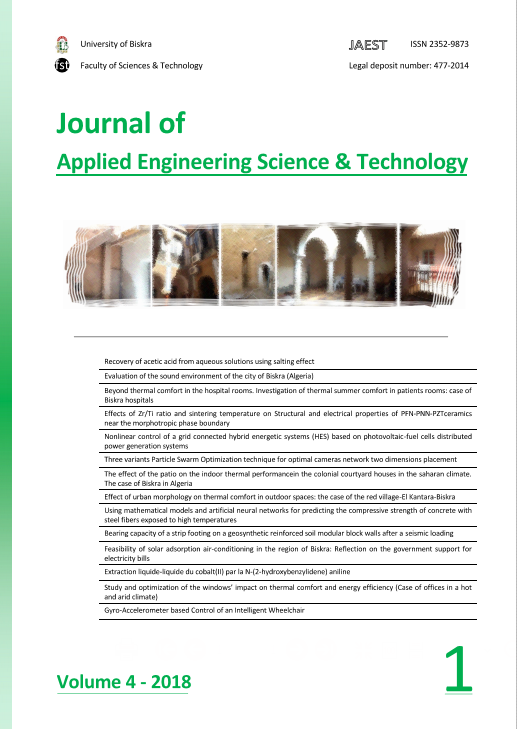DOI:
https://doi.org/10.69717/jaest.v4.i1.82Keywords:
Windows of the facade, Thermal comfort, Energetic efficiency, Office building, Simulation, Hot and arid climateAbstract
Controlling the thermal environment and reducing the energy consumption of buildings across the façade are a difficult challenge for architects, especially in a desert climate. The windows in particular play an important role in the tandem of the thermal operation of the building and the comfort of the users. The objective of this article is to study and optimize the impact of windows, their material and proportional characteristics on the thermal comfort and energy efficiency of office buildings in a hot and arid climate. The investigation is based on an empirical approach (measurements taken in situ on real cases) as well as on a numerical simulation study with the TRNSYS program. Several parameters have been studied such as surface temperature, ambient temperature and energy consumption. The results showed that facade windows are a determining factor in the thermal exchanges between the building and its environment and that the key parameters that condition these exchanges are the windows ratio (glazed area) and the type of glazing. The judicious choice of the windows ratio combined with an appropriate choice of the type and composition of the glazing improves the thermal comfort of the users and ensures the energy performance of the building.
Downloads
Downloads
Published
Issue
Section
How to Cite
Most read articles by the same author(s)
- Sihem Latreche, Leila Sriti, Improving thermal comfort conditions through the optimization of the self-product residential buildings envelope. Case of a region with a hot and arid climate: Biskra , Journal of Applied Engineering Science & Technology: Vol. 4 No. 2 (2018): JAEST
Similar Articles
- Toufik Arrif1, Adel Benchabane, Abdelmadjid Chehhat, Abdelfetah Belaid, Amar Rouag, Numerical simulation of convective heat losses in a helical tube of a cylindrical solar receiver , Journal of Applied Engineering Science & Technology: Vol. 4 No. 2 (2018): JAEST
- Tallal Abdel Karim Bouzir, Nourdinne Zemmouri, Evaluation of the sound environment of the city of Biskra (Algeria) , Journal of Applied Engineering Science & Technology: Vol. 4 No. 1 (2018): JAEST
- Mohamed Baheddi, Youcef Youb, Study of the behavior of bridges under seismic loads considering soil-structure interaction , Journal of Applied Engineering Science & Technology: Vol. 1 No. 2 (2015): JAEST
- Farid Touloum, Akli Younsi, Abdelhak Kaci, Adel Benchabane, Formulation of a composite of date palm wood‐cement , Journal of Applied Engineering Science & Technology: Vol. 2 No. 2 (2016): JAEST
- Oussama Temami, Djamal Hamadi, Abdallah Zatar, Ashraf Ayoub, Experimental and numerical analyses of a thin cylindrical shell model , Journal of Applied Engineering Science & Technology: Vol. 2 No. 2 (2016): JAEST
- Djamel Taibi, Stability analysis of the extended Kalman filter for Permanent Magnet Synchronous Motor , Journal of Applied Engineering Science & Technology: Vol. 1 No. 2 (2015): JAEST
- Loubna Ben Amor, Ahmed Boutarfaia, Omar Bentouila, Effects of Zr/Ti ratio and sintering temperature on Structural and electrical properties of PFN-PNN-PZTceramics near the morphotropic phase boundary , Journal of Applied Engineering Science & Technology: Vol. 4 No. 1 (2018): JAEST
You may also start an advanced similarity search for this article.





